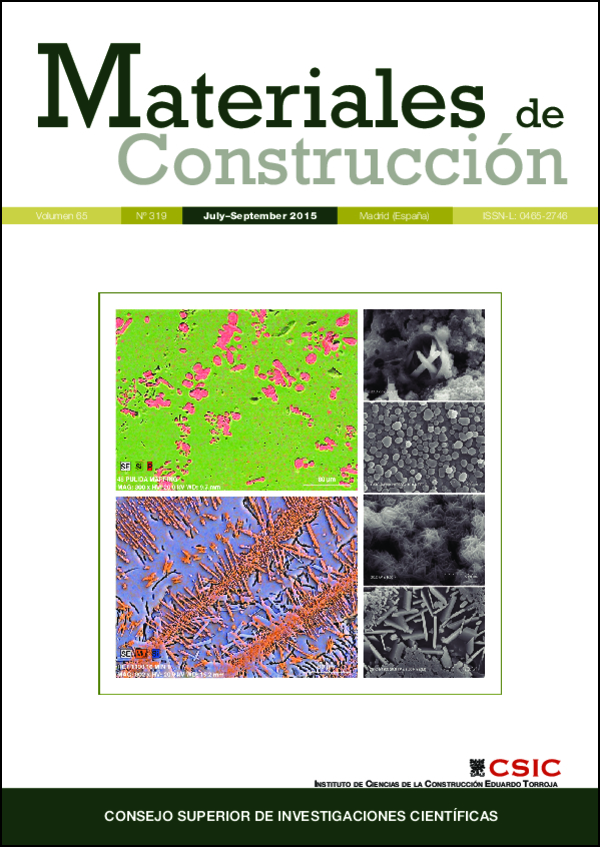Characterization and influence of fine recycled aggregates on masonry mortars properties
DOI:
https://doi.org/10.3989/mc.2015.06014Keywords:
Mortar, Waste treatment, Aggregate, Characterization, Mechanical propertiesAbstract
This research aims to study mechanical behaviour and relevant properties of masonry mortars fabricated using fine recycled aggregate in different mixture proportions. Fine recycled aggregates samples originated from the ceramic and concrete recycling process and coming from two recycling plants of Madrid region have been used. Tests were performed using 1:3:0.5 volumetric cement-to-aggregate-to-water ratio. Standardized sand with fine recycled aggregate replacement percentages were: 10%, 15%, 25%, 35% and 45%. A continuous size distribution curve can be observed and the main crystalline phases determined have been quartz, calcite and gypsum. Compressive strength, shrinkage and bond strength tests revealed poorer performance of recycled mortars compared to the conventional mortars; however, specific values are within the limits established by the manufacturers and standards. This study shows that cement-based mortars prepared with volumetric ratio 1:3:0.5 may contain up to 45% of fine recycled aggregates, without their properties being affected and without presenting significant losses.
Downloads
References
1. Villoria, P.; del Río, M.; Porras, C.; de San Antonio, A. (2011) European Legislation and Implementation Measures in the Management of Construction and Demolition Waste. The Open Constr. Build. Technol. J. 5 [Suppl 2-M6], 156–161. http://dx.doi.org/10.2174/1874836801105010156
2. Etxeberria, M.; Vázquez, E.; Marí, A.; Barra, M. (2007) Influence of Amount of Recycled Coarse Aggregates and Production Process on Properties of Recycled Aggregate Concrete. Cem. Concr. Res. 37, 735–742. http://dx.doi.org/10.1016/j.cemconres.2007.02.002
3. Tam, V.W.Y.; Wang, K.; Tam, C.M. (2008) Assessing Relationship among Properties of Demolished Concrete, Recycled Aggregate and Recycled Aggregate Concrete using Regression Analysis. J. Hazard. Mater. 152, 703–714. http://dx.doi.org/10.1016/j.jhazmat.2007.07.061 PMid:17764837
4. Debieb, F.; Courard, L.; Kenai, S.; Degeimbre, R. (2009) Roller Compacted Concrete with Contaminated Recycled Aggregates. Constr. Build. Mater. 23, 3382–3387. http://dx.doi.org/10.1016/j.conbuildmat.2009.06.031
5. Yagishita, F.; Sano, M.; Yamada, M. (1994) Behaviour of Reinforced Concrete Beams Containing Recycled Coarse Aggregate. In: Lauritzen Erik, K., editor. Demolition and reuse of concrete. RILEM, 331–342.
6. Nishbayashi, S.; Yamura, K. (1998) Mechanical Properties and Durability of Concrete from Recycled Coarse Aggregate prepared by crushing Concrete. In: Proceedings of the second international RILEM, Symposium on Demolition and Reuse of Concrete and Masonry, 652–659.
7. Vegas, I.; Azkarate, I.; Juarrero, A.; Frias, M. (2009) Design and Performance of Masonry Mortars Made with Recycled Concrete Aggregates. Mater. Construcc. 95 [295], 5–18. http://dx.doi.org/10.3989/mc.2009.44207
8. Corinaldesi, V.; Moriconi, G. (2009) Behaviour of Cementitious Mortars containing Different kinds of Recycled Aggregate. Constr. Build. Mater. 23, 289–294. http://dx.doi.org/10.1016/j.conbuildmat.2007.12.006
9. Jiménez, J.R.; Ayuso, J.; López, M.; Fernández, J.M.; De Brito, J. (2013) Use of Fine Recycled Aggregates from a Ceramic Waste in Masonry Mortar manufacturing. Constr. Build. Mater. 40, 679–690. http://dx.doi.org/10.1016/j.conbuildmat.2012.11.036
10. Miranda, L.F.R.; Selmo, S.M.S. (2006) CDW recycled aggregate renderings: Part I – Analysis of the effect of materials finer than 75 μm on mortar properties. Constr. Build. Mater. 20, 615–633. http://dx.doi.org/10.1016/j.conbuildmat.2005.02.025
11. Limbachiya, M.C.; Marrocchino, E.; Kouloris, A. (2007) Chemical-Mineralogical Characterisation of Coarse Recycled Concrete Aggregate. Waste Manage. 27, 201–208. http://dx.doi.org/10.1016/j.wasman.2006.01.005 PMid:16574393
12. Angulo, S.C.; Ulsen, C.; John, V.M.; Kahn, H.; Cincotto, M.A. (2009) Chemical-Mineralogical Characterization of C&D Waste Recycled Aggregates from São Paulo, Brazil. Waste Manage. 29, 721–730. http://dx.doi.org/10.1016/j.wasman.2008.07.009 PMid:18926692
13. Bianchini, G.; Marrocchino, E.; Tassinari, R.; Vaccaro, C. (2005) Recycling of Construction and Demolition Waste Materials: a Chemical and Mineralogical Appraisal. Waste Manage. 25, 149–159. http://dx.doi.org/10.1016/j.wasman.2004.09.005 PMid:15737712
14. Rolón, J. C.; Nieves, D.; Huete, R.; Blandón, B.; Terán, A. (2007) Caracterización del Hormigón elaborado con Áridos Reciclados producto de la Demolición de Estructuras de Hormigón. Mater. Construcc. 57 [288], 5–15.
15. Martín, M.; Zamorano, M.; Ruiz, A.; Valverde, I. (2011) Characterization of Recycled Aggregates Construction and Demolition Waste for Concrete production following the Spanish Structural Code EHE-08. Constr. Build. Mater. 25, 742–748. http://dx.doi.org/10.1016/j.conbuildmat.2010.07.012
16. Silva, J.; de Brito, J.; Veiga, R. (2009) Incorporation of Fine Ceramics in Mortars. Constr. Build. Mater. 23, 556–564. http://dx.doi.org/10.1016/j.conbuildmat.2007.10.014
17. Braga, M.; de Brito, J.; Veiga, R. (2012) Incorporation of Fine Concrete Aggregates in Mortars. Constr. Build. Mater. 36, 960–968. http://dx.doi.org/10.1016/j.conbuildmat.2012.06.031
18. Martínez, I.; Etxeberria, M.; Pavón, E.; Díaz, N. (2013) A Comparative Analysis of the Properties of Recycled and Natural Aggregate in Masonry Mortars. Constr. Build. Mater. 49, 384–392. http://dx.doi.org/10.1016/j.conbuildmat.2013.08.049
Published
How to Cite
Issue
Section
License
Copyright (c) 2015 Consejo Superior de Investigaciones Científicas (CSIC)

This work is licensed under a Creative Commons Attribution 4.0 International License.
© CSIC. Manuscripts published in both the printed and online versions of this Journal are the property of Consejo Superior de Investigaciones Científicas, and quoting this source is a requirement for any partial or full reproduction.All contents of this electronic edition, except where otherwise noted, are distributed under a “Creative Commons Attribution 4.0 International” (CC BY 4.0) License. You may read here the basic information and the legal text of the license. The indication of the CC BY 4.0 License must be expressly stated in this way when necessary.
Self-archiving in repositories, personal webpages or similar, of any version other than the published by the Editor, is not allowed.


















